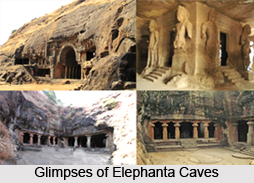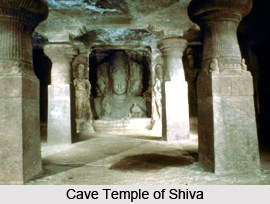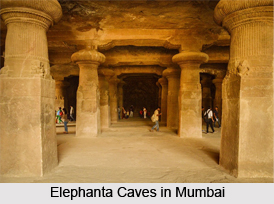 About ten kilometers north east of Apollo Bunder near the Gateway of India, lay the island of Elephanta, which was anciently known as Gharapuri, the island capital of Konkan Mauryas. A great tourist attraction in the vicinity of the large Mumbai metropolis, this cave temple was excavated sometime in the 8th century by the Rashtrakuta kings, who ruled the area from 757-973 AD. These rock cut temples dedicated to Shiva Mahadeva are rich in sculptural content. This island is the glorious abode of Lord Shiva and is celebrated for its colossal image of Mahesa-murti with three heads each representing a different form. This image is of the Great Lord Shiva, which is an 18-foot triple image. The cave complex has been given the status of a world heritage site by UNESCO in 1987.
About ten kilometers north east of Apollo Bunder near the Gateway of India, lay the island of Elephanta, which was anciently known as Gharapuri, the island capital of Konkan Mauryas. A great tourist attraction in the vicinity of the large Mumbai metropolis, this cave temple was excavated sometime in the 8th century by the Rashtrakuta kings, who ruled the area from 757-973 AD. These rock cut temples dedicated to Shiva Mahadeva are rich in sculptural content. This island is the glorious abode of Lord Shiva and is celebrated for its colossal image of Mahesa-murti with three heads each representing a different form. This image is of the Great Lord Shiva, which is an 18-foot triple image. The cave complex has been given the status of a world heritage site by UNESCO in 1987.
History
These caves are a collection of seven caves and these are thought to date back to the Silhara kings of the 9th through the 13th centuries (810-1260). Some of the sculptures of this site are also attributed to the imperial Rashtrakutas of Manyakheta (in present day Karnataka). The Trimurti of Elephanta showing the three faces of Shiva almost akin to the Trinity of Brahma, Vishnu, and Maheswar embodied as one being one among them. This was also the royal insignia of the Rashtrakutas. The Portuguese took possession of the island and the Elephanta Island was so named by the Portuguese.
They had found a monolithic stone elephant at the place where they landed and also named this a "ilha do elephanta", island of the elephant. The figure collapsed in 1814 and it was subsequently moved to the far-off Victoria Gardens and reassembled. There was a stone horse too, a little further, which has a vanished without a trace. Unfortunately, iconoclastic Portuguese rulers who took potshots at Hindu Gods with their rifles have damaged many of the sculptures inside. The Portugese built a fort here with a watchtower, hoisting up to flag to ward off attacks by pirates boats.
Shortly before these temples were created, Bombay experienced the golden age of the late Guptas, under whom the talents of artists had free range. Sanskrit had been finely polished, and under the court`s liberal patronage, Kalidasa and other writers had helped incite a revival of Hindu beliefs. It was Shivaism - the worship of Shiva - that inspired the building of these temples.
 Site & Architecture
Site & Architecture
Cave Temple: The entire cave temple, which is the pride of the elephanta complex, covers an area of about 60000 square feet and is reached by climbing a flight of more than 100 steps, to the top of a hill. It consists of a main chamber and two lateral ones, courtyards and several subsidiary shrines. Inside the temple, there is a large pillared hall with rows of columns that appear to hold up the roof of the cave. The main body of the cave, excluding the porticos on the three open sides and the back isle, is 27 metres square and is supported by rows of six columns each.
Cross beams complete the illusion of a ceiling, where there are a series of marvelous sculptured panels, nine in all, which are set like tableaux on the walls. Little is known about the architects and sculptors, who worked on this gem of ancient architecture. Each of the panel captures the volatility of Shiva`s essentially paradoxical nature, and the magical interplay of light and shade, only intensifies the overall effect.
Carving out rock, and creating the columns, the internal spaces and the images created this rock cut temples. Above the temple is the mass of natural rock. The entire temple is akin to a huge sculpture, through whose corridors and chambers one can walk. The entire complex was created through a process of rock removal. Some of the rock surfaces are highly finished while some are untreated bare rock.
There are three entrances to this temple. The ones on the east and the west mark the axis of the temple. To the east of the main temple is a courtyard, flanked by the secondary shrine. This temple contains six pillars at its entrance, four of which are free standing and two engaged. The entrance leads to a hall decorated with sculptured panels depicting legends from the Shiva Purana. A 20 pillared hall lines the axis, and on its western end is the cella in which is enshrined a Shivalingam. The pillars consist of fluted columns standing on square bases, and are crowned with fluted cushion capitals.
Trimurti Shiva: The enigmatic image of Trimurti Sadasiva is carved in relief at the end of the north south axis. This image is at the entrance to the caves and is the celebrated trinity of Elephanta: there`s Lord Brahma the Creator, Lord Vishnu, the preserver and Lord Shiva the Destroyer. This collossal 20 feet high image of the three headed Shiva, Trimurti is a magnificent one and considered to be a masterpiece of Indian art. This colossal image represents Panchamukha Shiva, only three faces of whom are carved into the wall and it demands immediate attention upon entering the temple through the northern entrance.
 The Trimurti represents the three faces of Mahesh or Shiva, which shows Shiva as a young person with sensuous lips, embodying life and its vitality. In his hand he holds something that resembles a rose bud -- again with the promise of life and creativity. It is this face that is closest to that of Brahma, the creator. The other face on the side is that of a young man. It is mustachioed, and displays anger. This is Shiva as Rudra, as the one whose anger can engulf the entire world in flames leaving only ashes behind. This is Shiva the Destroyer. And there is the central face, benign, meditative, as the preserver. This is Shiva as the yogi - Yogeshwar - in deep meditation praying for the `preservation` of humanity. This is Shiva in all the three manifestations of what is conventionally seen as Brahma, Vishnu and Shiva.
The Trimurti represents the three faces of Mahesh or Shiva, which shows Shiva as a young person with sensuous lips, embodying life and its vitality. In his hand he holds something that resembles a rose bud -- again with the promise of life and creativity. It is this face that is closest to that of Brahma, the creator. The other face on the side is that of a young man. It is mustachioed, and displays anger. This is Shiva as Rudra, as the one whose anger can engulf the entire world in flames leaving only ashes behind. This is Shiva the Destroyer. And there is the central face, benign, meditative, as the preserver. This is Shiva as the yogi - Yogeshwar - in deep meditation praying for the `preservation` of humanity. This is Shiva in all the three manifestations of what is conventionally seen as Brahma, Vishnu and Shiva.
About the Trimurti, historian Grousset points out, "The three countenances of the One Being are here harmonized without a trace of effort. There are few material representations of the divine principle at once as powerful and as well balanced as this in the art of the whole world".
Set in various niches is a number of large reliefs depicting different aspects of Shaivaite iconography. Other sculptures near the doorways and on side panels show Shiva`s usefulness. Shiva brought the Ganges River down to Earth, the story says, letting it trickle through his matted hair. Thus, on the southern wall are the other Rashtrakuta grand sculptured compartments in this cave with remarkable images of Lord Shiva depicting him as Kalyanasundara (the gentle loving God), Gangadhara, Ardhanariswara (Shiva and Shakti, male and female) and Uma Maheswara.
To the west of the northern entrance are sculptured images of Nataraja (Shiva as the many-armed cosmic dancer) and Andhakaasuravadamoorthy (impaling the demon of darkness). To its east are images of Yogiswara (Lord of the Yogis, seated on a lotus) and Ravanaanugrahamurthy (the destroyer of enemies). The gigantic figures of `dvarapalas` or doorkeepers are very impressive.
Thus in the Elephanta caves, Shiva is portrayed in the non anthropomorphic Shivalingam form, as well as in his quintessential being emanating from the Shivalingam in the colossal image, and in 8 manifest forms, where the beauty of this stonework lies in the grace, balance, and sense of peace conveyed in spite of the subject`s multiple actions.




